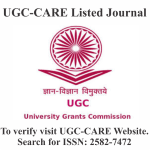EARTHEN ART - THE CERAMIC HERITAGE OF NEOLITHIC KASHMIR
DOI:
https://doi.org/10.29121/shodhkosh.v5.i2.2024.951Keywords:
Neolithic Culture, Pottery, Earthen Art, Heritage, KashmirAbstract [English]
Neolithic art marks a turning point in the evolution of human culture, from roving hunter-gatherer cultures to permanent agricultural settlements. This change aided in the development of new technology, social structures, and most significantly, the advancement of art and craftsmanship. Because of its practical and ceremonial applications, pottery-making emerged as a prominent craft. This essay investigates the evolution of art throughout the Neolithic era, concentrating on the techniques, styles, and cultural significance of pottery manufacture. The art of the ceramic heritage of Neolithic Kashmir represents a significant aspect of the Kashmir's early human history, showcasing the development of pottery and earthen art from the Neolithic period. This heritage is not just a testament to the artistic skills of ancient peoples but also provides insights into their daily lives, societal structures, and interactions with the environment. Neolithic sites in Kashmir have yielded a wealth of pottery pieces, characterized by their fine finishes, intricate designs, and functional forms. These artefacts indicate a high level of craftsmanship and an understanding of ceramic technologies that were advanced for their time. The pottery often features geometric patterns, animal figures, and other motifs that may have held cultural or symbolic significance. The earthenware from Neolithic Kashmir is typically made from locally sourced clay, shaped by hand or with simple tools, and then fired in kilns or open fires to achieve durability. The variety of forms—from storage jars and cooking pots to bowls and plates - suggests a diversified use in daily activities such as food preparation, storage, and consumption. These ancient ceramics also provide evidence of trade and cultural exchange. Variations in styles and techniques between different sites within the region, and similarities with pottery found in other parts of South Asia, suggest that Neolithic communities in Kashmir were not isolated but part of a broader network of interaction. The study of Neolithic Kashmir's ceramic heritage is crucial for archaeologists and art historians as it helps reconstruct the lifestyles, technological advancements, and aesthetic sensibilities of early societies in the region. Additionally, it underscores the importance of preserving such art and skill at the archaeological sites, which face threats from environmental factors, urban development, and illicit trafficking.
References
Allchin, F.R., & Bridget, A. (1996). Rise of Civilization in India and Pakistan. Cambridge University Press, 33.
Bandey, A. A. (2009). Prehistoric Kashmir: Archaeological History of Palaeolithic and Neolithic Cultures, Dilpreet Publishing House, New Delhi, 69-80, 122-135.
Betts, A., Yatoo, M., Spate, M., Fraser, J., Kaloo, Z., Rashid, Y., Pokharia, A., & Zhang, G. (2019). The Northern Neolithic of the Western Himalayas: New Research in the Kashmir Valley, Archaeological Research in Asia 18, 17-39. https://doi.org/10.1016/j.ara.2019.02.001 DOI: https://doi.org/10.1016/j.ara.2019.02.001
Blakely, J. A., & Bennett, W.J. (1989). Analysis and Publication of Ceramics-The Computer Data-Base in Archaeology, BAR International Series, 551, 6-7. https://doi.org/10.30861/9780860546986 DOI: https://doi.org/10.30861/9780860546986
Burkit, M.C. (1926). Our Ealy Ancestors. Cambridge University Press, 50-57.
Ghosh, A. (1964). Indian Archaeology 1961-62 A Review. Archaeological Survey of India Faridabad, 19.
Khazanchi, T.N., & Dikshit, K.N. (1980). The Grey ware Culture of Northern Pakistan, Jammu and Kashmir and Punjab. Puratattva, No. 9, The Indian Archaeological Society, New Delhi, 49.
Mani, B.R. (2000). Excavations at Kanispur: 1998-99 (District Baramulla Kashmir). Journal of Interdisciplinary Studies in History and Archaeology 10, Centre of Advanced Study, Dept. of Ancient History, Culture, and Archaeology, University of Allahabd, Allahabad, 1-28.
Mani, B.R. (2008). Kashmir Neolithic and Early Harappan: A Linkage, Pragdhara, 18, Varanasi, 229-247.
Mitra, D. (1984). Indian Archaeology 1981-82 A Review: Archaeological Survey of India, Calcutta, 16-25.
Pant, R.K., Gaillard, C., Nautiyal, V., Gaur, G.S., & Shali, S.L. (1982). Some New Lithic and Ceramic Industries from Kashmir, Man and Environment, VI, 37-40.
Saar, S.S. (1992). Archaeology: Ancestors of Kashmir, Lalit Art Publishers New Delhi.
Sevizzero, S., & Tisdell, C. A. (2014). The Neolithic Revolution and Human Societies: Diverse Origins and Development of Paths, HAL-02153090, 10.
Shali, S.L. (1993). Kashmir: History and Archaeology through the Ages. Delhi: Indus Publishing Company, 27-33.
Yatoo, M. (2012). 'Characterising Material Culture to Determine Settlement Patterns in North West Kashmir', Ph. D. Thesis, School of Archaeology and Ancient History, University of Leicester, 197-245.
Published
How to Cite
Issue
Section
License
Copyright (c) 2024 Abdul Adil Paray, Dr. Manoj Kumar

This work is licensed under a Creative Commons Attribution 4.0 International License.
With the licence CC-BY, authors retain the copyright, allowing anyone to download, reuse, re-print, modify, distribute, and/or copy their contribution. The work must be properly attributed to its author.
It is not necessary to ask for further permission from the author or journal board.
This journal provides immediate open access to its content on the principle that making research freely available to the public supports a greater global exchange of knowledge.




















